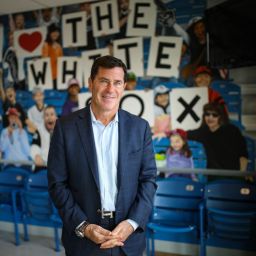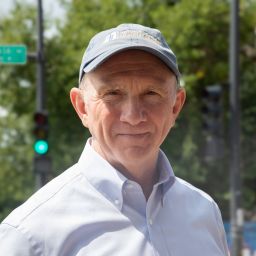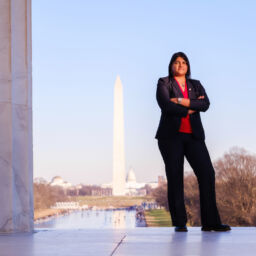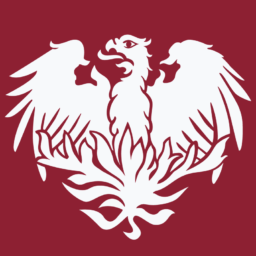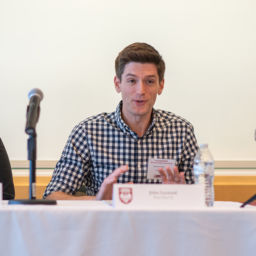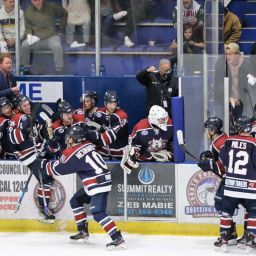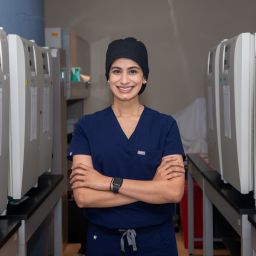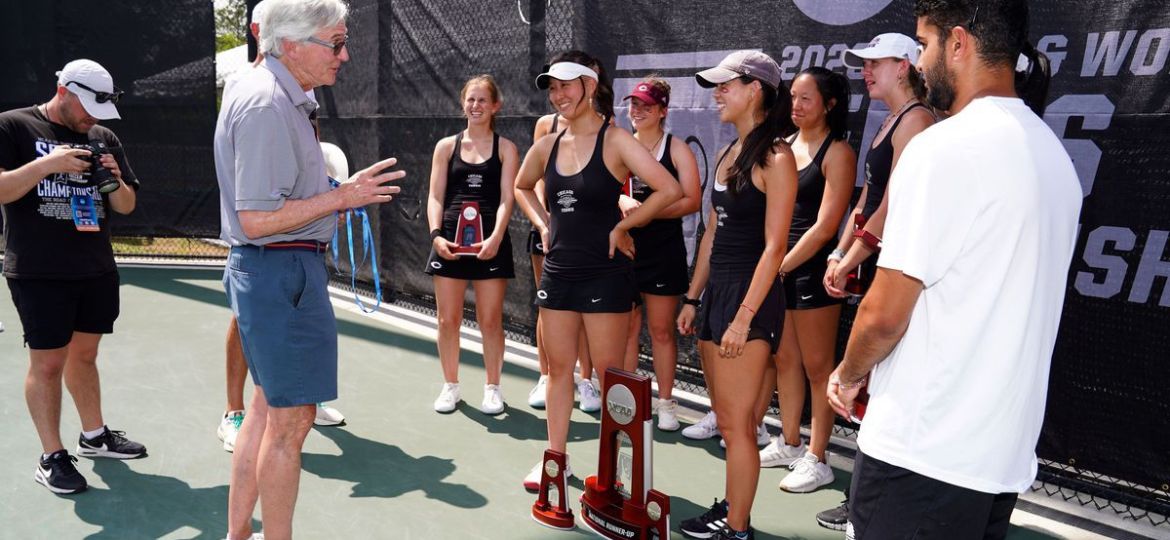
Brian Hainline, MD’82
Location: Indianapolis and New York
- First (and current) chief medical officer of the NCAA
- Chief medical officer of the U.S. Open Tennis Championships
- Chair of the board and president of the United States Tennis Association
- Architect of a joint 25-year concussion study by the NCAA and the U.S. Department of Defense
Powerful Pritzker influences
Pritzker faculty and staff had a major impact on Hainline’s life and career. Mentors included founding Chair of Neurology Barry Arnason, MD, who introduced Hainline to the fast-growing field of neuroimmunology, and cancer expert John Ultmann, MD, whom the students nicknamed “The Ultimate Man” because of his strict demands for order.
“Ultmann ran everything like a Marine sergeant,” Hainline said. “I learned more from him about medicine than anyone in my life.”
A philosophy major and top tennis player at the University of Notre Dame, Hainline also bonded with internist Mark Siegler, MD, who established the field of clinical medical ethics. The two often engaged in long discussions about moral medical decisions.
While at Pritzker, Hainline met his future wife, Pascale, a Sorbonne graduate working on a post-master’s fellowship in economics at the University of Chicago. The two lived in the same dorm, International House. They’ve been married for more than 43 years. Their daughter, Juliette, is a 2018 UChicago alumna with a bachelor’s degree in computer science.
Hainline continues to support the school through donations and volunteering his service to students. “University of Chicago was foundational for who I am as a physician and who I am as a human being,” he said.
A tragedy becomes a mission
One of Hainline’s closest friends at UChicago was Randy Chauvin, a PhD student who developed glioblastoma and died before graduating. Devastated, Hainline finished his neurology residency at New York Hospital-Cornell Medical Center and focused his attention on research to find a cure for this still-fatal disease.
Paving new paths
Six years into his brain tumor research, a friend and former resident colleague called Hainline from the Hospital for Joint Diseases. He needed help dealing with an influx of sports and nerve injury patients, and asked Hainline to transition from his research to join him and become the inaugural director of clinical and sports neurology, a newly created position. “I said to him, ‘What’s sports neurology? That’s not even a defined field!’” Hainline recalled, laughing. But his friend was persistent, appealing to his background playing No. 1 singles and doubles tennis at Notre Dame. “He said, ‘I know. You’re going to define it, and since you’re an athlete, you’ll figure out how to do it.’ It actually sounded intriguing, so I took the job and started this division called sports neurology.”
Within a year of working at the Hospital for Joint Diseases, the U.S. Open invited Hainline to become chief medical officer. He’d previously served as a consulting physician for the tennis organization and set up their anti-doping program. This time, they wanted him to develop a plan to address issues ranging from heat stroke to potentially career-ending musculoskeletal injuries. “I said, ‘I can’t be CMO, I’m a neurologist! The orthopaedic surgeons are going to go crazy about this!’ — which they did, by the way,” he said. Given his love of tennis, it was a dream job. So Hainline happily accepted and spent the next 16 years with the U.S. Open, creating a comprehensive approach to sports injuries, where a team could respond to any medical situation within three minutes. He continued to emerge as a leader in this new field of sports medicine and sports neurology, serving on the U.S. Olympic Committee’s sports medicine commission from 1997 to 2000.
A quick, big decision
A memorable U.S. Open moment involved tennis legend Pete Sampras, on the cusp of winning a record-setting 13th Grand Slam in 1999. While warming up for the tournament, Sampras hit a backhand that caused severe midline back pain. Hainline examined him and determined he had a large herniated disc. To win a Grand Slam, a player must win seven matches, each between two and five hours long. Hainline had little time to decide whether to advise Sampras to drop out of the tournament and rehabilitate, or to “make him pain-free” so he could play. He recommended Sampras withdraw, which he did, making headlines worldwide. Sampras recovered from his injury and went on to win two more Grand Slams.
Concussion study
After he became the NCAA’s CMO in 2013, Hainline wanted to study concussions and chronic traumatic encephalopathy (CTE) — a serious and understudied problem facing college athletes at the time. While assembling a team of top concussion experts, he met with Col. Dallas Hack, MD, MPH, director of the U.S. Army Combat Casualty Care Research Program. Hack was studying traumatic brain injuries among service members for the U.S. Department of Defense.
“Biomechanically, the majority of head injuries in the military are very similar to sports concussions,” Hainline said. “So we thought, what if we do a jointly funded study that looked at all types of concussions, for NCAA athletes and the military’s four service academies?”
The result was a 25-year, more than $100 million study, launched in 2014, which White House officials described as “the most comprehensive concussion database ever.” The multipart study has tracked 55,000 service academy cadets and student-athletes from all 24 NCAA sports. It obtained their baseline measurements for things like blood biomarkers and followed up on concussion cases with advanced brain MRIs, genetics, genomics and head accelerometer data.
“It was a pretty ambitious goal, really,” Hainline said. “We’re about 10 years in now, and it’s already given us insight and helped shape policy.”
This initiative has helped spur a culture shift around concussions (away from the “man up and shake it off ” approach) and adjusted training techniques to avoid repeated, hard hits to the head. It also has led to research on related topics, including concussions in men versus women and genetic reasons why some people tolerate head trauma better than others.
A point of pride
Throughout his career, Hainline has emphasized collaboration with other organizations and experts, the most fulfilling part of his job. It’s been key in helping him manage athlete-related issues ranging from COVID-19 to cardiac health.
He’s especially proud of his work to create an environment of wellness in the NCAA and a mental health best practices guide endorsed by 25 medical and scientific organizations, which became the springboard for an International Olympic Committee summit. The guide has helped reduce the stigma around depression and anxiety, and make mental health services more available.
“I don’t think the public always under- stands, the physicians and clinicians involved in sports love sports and want to do it right. They’re not doing it to advance their agenda. It’s everyone coming together for a greater common, public good,” Hainline said. “It’s been such an incredible opportunity and humbling experience to be surrounded by so many brilliant people. What could be better than that?”
Read the full story on Medicine on the Midway.



